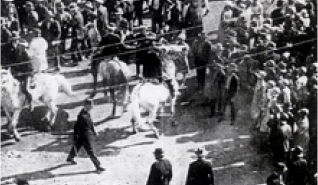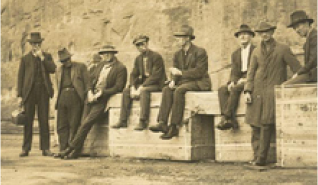Our History
The Construction, Forestry, Maritime and Employee Union is an amalgamation of a great many unions, each with their own proud history.
Construction & General
Manufacturing
Maritime

1990s
The Construction and General Division was formed in the early 1990s with the creation of the national CFMEU. The creation of a single building union had been a policy objective of various building unions for decades with records showing the Queensland Branch of the Operative Painters and Decorators Union (OPDU) carried resolutions calling for a single industry union to be created as early as the 1920s. The rationale behind this policy position was the logical view that members would be better represented by a larger industry-based union rather than the traditional craft unions.

2018

1907

1918

1990
In late 1990 a ballot was conducted by members of the Australian Timber Workers Union and the Pulp and Paper Workers Federation of Australia endorsing the amalgamation of both Unions to form the Australian Timber and Allied Industries Union. A further ballot was conducted in mid 1991 on the amalgamation between the Australian Timber and Allied Industries Union and the Building Workers Industrial Union. This endorsement supported the first stage in the development of a major Union, the Construction, Forestry, Mining and Energy Union which represents approximately 120,000 members. The Forest and Furnishing Products Division represents approximately 20,000 members nationally.

1870 - 1920
The history of the CFMEU Manufacturing Division goes back to the 1870's campaign for the 8 hour working day, where it was at the forefront of the campaign. 1920 was the start of an on going struggle in the forest and forest products industry to reduce the 48 hour working week to 44 hours. The successful campaign resulted in Justice Higgins making an order to reduce the working hours of sawmillers in the metropolitan areas. Country sawmillers remained on 48 hours per week.
Almost 7 years later, employers tried to reintroduce the 48 hour week across the industry, claiming sawmills were closing and jobs being lost because of the impact of the 44 hour week.

1928
In 1928 Judge Lukin gave his own interpretation of the award clause and reintroduced the 48 hour week.
There was controversy over the legitimacy of Judge Lukin's authority to alter or amend the award. In 1929 the case went to the full arbitration court, where the court hired an officer to investigate the claims made by employers about the effects of the 44 hour week and took into consideration Judge Lukin's interpretation of the award. The full arbitration court upheld Judge Lukin's decision of 1928 and the 48 hour week was consequently reintroduced across the country.
This was a time of great upheaval, when workers were subjected to violence, and imprisoned for standing up for their rights. in many instances, workers were locked out of their workplace by their employers.
As the reversion back to a 48 hour week affected only metropolitan workers, only 3000 of the 8000 workers in the industry supported the Union's campaign, resisting the employers' attacks and refusing to work the extra 4 hours unless paid overtime.
This dispute continued for two years in some States, before it returned to court and subsequently the industry reverted back to a 44 hour week.
The CFMEU Forest and Furnishing Products Division was one of the first Unions to achieve the 44 hour week and among the last to win it back. This had a devastating effect on the Union, which was financially crippled and brought to its knees. Despite the Union's exhausted financial situation, it maintained its struggle, never losing sight of the objective, which enabled the Union to continue and ultimately win back the 44 hour week. The very same passion and drive was responsible for restoring the financial viability of the Union.

1996
Since 1996 the Coalition Government has introduced a hostile industrial environment intended to reduce wages and conditions and abolish many entitlements through so-called industrial workplace reforms.
One demonstration of the ruthlessness and determination of this government to attack workers and their Unions was the atrocious and illegal acts perpetrated on the Maritime Union of Australia (MUA) in 1999.

2006
Michael O’Connor ascended to the position of the Forestry and Furnishing Division National Secretary in 2006, and began series of restructure and governance renewals in the face of numerous political, social and economic challenges. The National Office administration moved to Melbourne.
In 2007 the Forestry and Furnishing Division campaigned against the Howard Government’s WorkChoices agenda by initiating community education and establishing door knocking and protest actions. Organizers take a lead in bringing the message into workplaces and coordinating resistance within suburban, rural and regional communities. In timber/pulp and paper seats radical vote swings win at least ten seats for Labor.

2018
Around the same time in Victoria, the Federated Furniture Trades Society (Vic FFTS) begins a formal integration with the National Office of the Forestry and Furnishing Division, which became the Manuifacturing Division in 2018.
Throughout 2007-18 the Manufacturing Division has run and won a variety of campaigns against decisions taken by large corporations and State and Federal Governments that threatened Australian jobs. Fighting for our members' jobs and improving wages and conditions remains the Union's number one priority.
The Textile Clothing Footwear Union amalgamated with the CFMMEU Manufacturing Division in 2018.
The TCFUA was formed in 1992 after the Australian Textile Workers Union ( formed 1919 ) amalgamated with the Clothing and Allied Trades Union of Australia The Bookmakers union which was formed in 1907 had amalgamated with the Textile union prior to the amalgamation with the clothing union.

1872
The Sydney Wharf Labourers Union was established in 1872, eventually leading to formation of the Waterside Workers Federation in 1902. In 1906, several unions came together toform the Seamen's Union of Australia. During this period, the world witnessed great maritime strikes, especially in England and Australia, which would set the stage for internationalism and class struggle.

1914

1928

1929
The 1929 Depression hits maritime workers hard. Thousands of maritime workers could not find work, and membership in the WWF dropped by half. The Hungry Mile, the area at DarlingHarbour in Sydney, teemed with maritime workers walking from wharf to wharf looking for work.

1936 – 1972
James "Big Jim" Healy modernises the WWF, rising in 1937 to be its general secretary. He is the first editor of the WWF's journal, the Maritime Worker. He joins the Communist Party and is a committed internationalist, campaigning in support of waterside workers' boycotts of Japan and a boycott of Dutch ships from 1945-1949 as a way to bolster the Indonesian independence movement.

1936 – 1972

1936 – 1972
The gang system replaces the "bull" system, a revolutionary step forward. The "bull" system ensured that the largest men (the bulls) were chosen first for work, whilst other workers often missedout. Waterfront workers would, from that moment on and to this day, be picked up on the basis of rotation and equity (through rostered groups), rather than having to get work based on the whim of foremen or company preferences.

1936 – 1972
In November 1938, Port Kembla wharfies refuse to load pig iron on to the Dalfram, a boat bound for Japan. It is a courageous action, joining worldwide work stoppages to stop the flow ofiron and other war supplies to Japan in the years leading up to World War II. Wharfies fear that the pig iron will end up in bombs dropped on Australia, as well as instruments of war against China and other nations. By threating to bring in scab labour, Attorney General R. G. Menzies earns the historic label, "Pig Iron Bob". Ultimately, the Dalfram is loaded but future pig iron shipments cease

1972 - 1992

1972 - 1992

1972 - 1992

1972 - 1992

1993 – Present

1993 – Present

1993 – Present

1993 – Present



